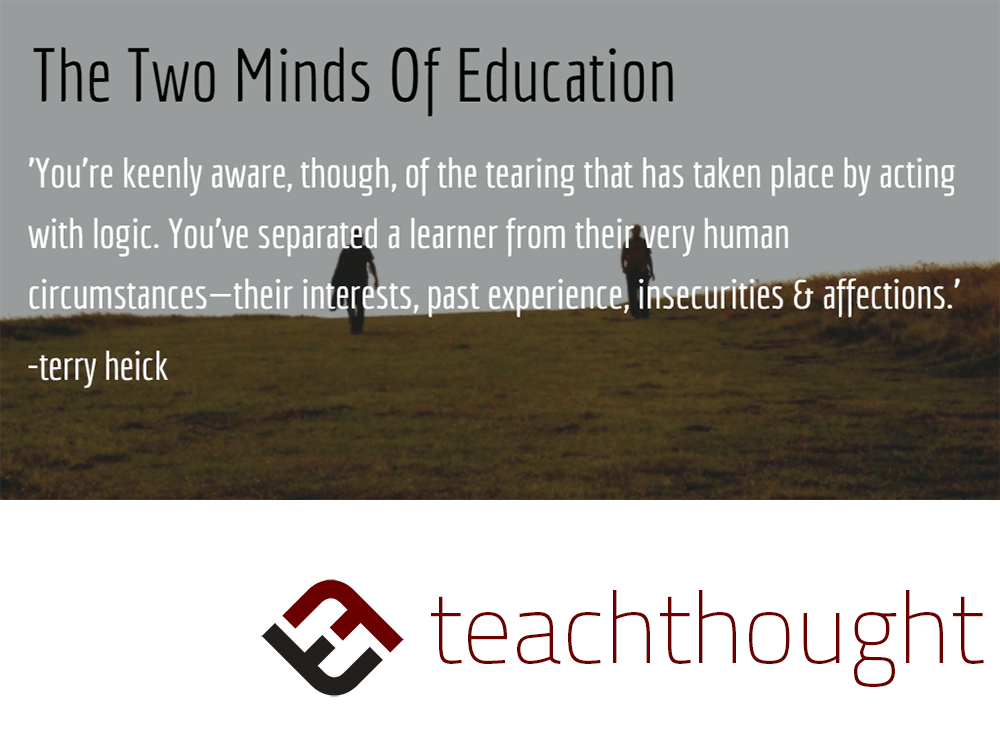

by Terry Heick
In his essay Two mindsWendell Berry, unsurprisingly, offers two tones of thought produced by two types of “mind”: rational and sympathetic.
One is motivated by logic, deduction, data and measurement, the other by affection and other useless abstractions: instinct, respect, joy and faith. These spirits struggle to manifest themselves in our collective behavior. In other words, they both seek to control our actions, what we say and do.
Berry explains their distinctions:
“The rational mind is motivated by the fear of being misled, of being wrong. Its goal is to exclude anything that cannot be proven empirically or experimentally by facts.”
The sympathetic mind is motivated by the fear of error of a very different kind: the error of negligence, of lack of love. Its goal is to be attentive to everything that is present, to leave nothing behind.
It’s no surprise that these two mindsets also exist in education. These are instincts you’ve probably had as an educator: a teacher, administrator, developer, or designer. Probably also as a parent if you have children. The need to be rational, deductive and strategic clashes with the enormous complexity and scale of the circumstances you face.
You are told to be data-driven, that is, to design a learning experience with “strategies” suggested by some action you have taken.
You might plan lessons and units by asking yourself why this teaching strategy? Why this evaluation form? Why regroup at this point in the lesson rather than at that point? Why this standard with this novel?
This is your rational mind.
But your rational mind is in service of a different kind of thinking – in fact, it is awakened and stimulated by a kind of insecurity that realizes the undoubted importance and concomitant impossibility of what you have made your life’s work: teaching dozens and dozens of other human beings what they need to know (insert your content area here).
The rational mind (the same mind that directs policies and standards) wants to analyze this task and respond to it logically. Preventively, strategically and analytically.
So rather than worry that this student I can’t read and this student is a brilliant artist ready for a professional mentor to develop his gift and this student needs both a hug and self-knowledge more than content knowledge, you answer analytically. Your rational mind takes over.
You look at the standards, bar charts, and summary books from Marzano and Hattie that list the teaching strategies that their rational minds think will work. You listen to your colleagues, your educational coach and anyone else willing to advise you. Then you teach, assess, reteach, reassess, correct, extend and move on.
However, you are perfectly aware of the heartbreak that took place by acting logically. You have separated a learner from their very human situation: their interests, their past experiences, their insecurities and their affections.
Academic content from their native schema.
Skill through curiosity.
Scientific concepts from the application of science.
Reading level for the love of reading.
The rational mind necessarily excludes curiosity, love, affection, and joy because they are inherently irrational. We live in an age of information which is itself a period of Enlightenment. By design, data and rationality cannot tolerate abstraction and humanity, otherwise they would break down in confusion.
But this requires an adjustment on our part. We need to stop being stubborn about what we are seeing more and more in our students. Apathy. Distraction. Superficial character.
As an industry, we are currently not only motivated but dangerously preoccupied with research, science and what is measurable and observable, having freed our profession from superstitions like “patience”, “self-knowledge” and “community”.
We leave it to teachers to mitigate the collision of students and sterile academic policies or standards with communities that need more than student competence. But if we are “attentive to all that is present” and willing to “leave nothing behind,” we can now see that pure rationality is not entirely a “spirit,” but an instinctive reaction to the magnitude of our task.
A challenge for you and me might then be to elevate the teaching beyond singularities through a kind of marriage – joining our rational and sympathetic minds into something inclusive, enlightened and whole.
Always insisting, no matter what, that we do not resort to rationality or even sympathy, but rather act as “full teachers” in each of our interactions and analyzes with students, and, in doing so, model for them the meaningful practice of being human.
Image attribution, Flickr user NASA Goddard Space Flight Center; Becoming a “complete teacher”



